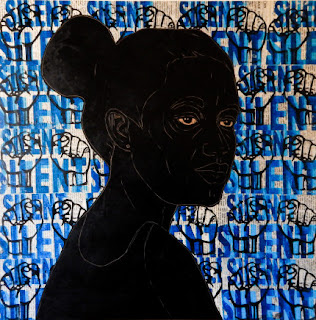Kerry James Marshall - Untitled (Pink Towel) 2014
These new figures by Solomon though, are at turns defiantly confrontational, and at others world-weary and resigned. They have to bear the burden of their blackness and the black experience with all that that entails in this world. As a result of this the woodcuts here have now become politicised. Solomon is expressing a sense of Black Pride, depicting characteristically defiant symbols of the Black Power movement of the 1960s and 1970s, such as slogans and clenched fists. Some of the woodblocks such as the picture below, resemble police mugshots, in which the young man has been targeted for his blackness alone perhaps. Or perhaps he knows too much about how certain corrupt police officers operate, what the police actually have working for them, and the interesting technologies they use to illegally target certain black men with surveillance. Perhaps.
In my previous post on Solomon I likened his woodcuts to the work of the German Expressionists. In these new works Solomon's woodcuts have evolved in scale, and appear to have achieved the sophistication, and economy of line, of the linocuts of Matisse with their fluid, negative line technique. The shot of colour used in the background texts gives the pictures a needed lift and contrasts with the solemnity of the black figures. The snippets of text also provide abstract pattern. Solomon's signature motif of chairs, representing authoritarian regimes, still make appearances in some of the pictures accompanied by bananas, or upturned with footprints stamped across the background, suggestive of corruption and political turmoil. I really like Solomon's unusual woodcut technique, and look forward to seeing in which direction Solomon takes his work next.
Henri Matisse - Pasiphae Portfolio, 1944
Ephrem Solomon: Silence
until 3rd February
Kristin Hjellegjerde
533 Old York Road
SW18
www.kristinhjellegjerde.com















